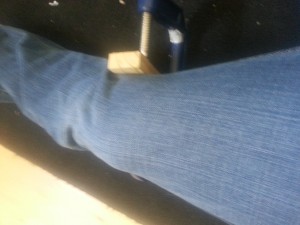Note: This post will provide evidence that LSJL does not merely expand the synovial joints but directly lengthens the bone.
I provided what I consider to be fairly irrefutable proof that I’ve increased finger length. The issue is that finger length doesn’t come into play in athletics that much. Larger hands could help in places where increased surface area would come into play. I also increased wingspan which is more helpful in athletics but I have no documentation and wingspan isn’t measured by doctors.
So I have to return to developing a better methodology for LSJL for the legs which would increase height which is measured by doctors and important in everything in contrast to more niche uses for finger length and wingspan. Here’s some of the methods I’ve tried. I got initial results but stopped over time. One of the reasons could have been that the results were due to dumbell loading since I stopped doing dumbell loading over time but I doubt that the results were due to dumbell loading since 65lbs is so slow. There might be some sort of adaptive mechanism that reduces effectiveness over time.
The question is: Why am I gaining length in my finger and arms but not in my legs?
The answer may be related to angular loading. When I clamp a bone it begins to bend at an angle. Before I was trying to keep it straight which resulted in the knee popping out in the clamp at the top. By allowing the knee to tilt the knee becomes trapped within the clamp stopping it from popping out. My finger and other arm joints always tilt when I’m clamping them and I gained length there so it makes that I can allow for the knee joint to tilt and still gain length in that region.
I’m using the block to increase surface area. I have to constantly adjust the block and clamp though for keeping it from slipping. Slipping is far more an issue for leg clamping still so there are further advancements to be made here.
After trying this method for a couple of weeks it was too inconsistent. Sometimes I would get a really good clamp and generate a lot of pressure other times the clamp would slip off before decent pressure was generated. So right now I’m using the Irwin Quick Grip and I’ll cover what I’m doing in part II. But right now I’m mainly focusing on one intense clamp rather than a certain time duration as before but bearing in mind to avoid injury which is possible since I am using so much force when clamping. Although the time duration method was working with fingers/wing span, I think maximizing intensity is working even better even for fingers/arms.
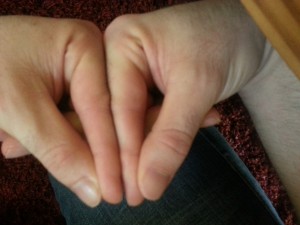 I got a better angle of the finger length comparison. I am only clamping my right finger and not my left. You can clearly see that the right finger is definitively longer than the left. It’s longer than it appears in the picture because I wanted to make sure the right knuckle was higher than the left so people didn’t think I was just sliding the right finger down.
I got a better angle of the finger length comparison. I am only clamping my right finger and not my left. You can clearly see that the right finger is definitively longer than the left. It’s longer than it appears in the picture because I wanted to make sure the right knuckle was higher than the left so people didn’t think I was just sliding the right finger down.
Here’s another angle:
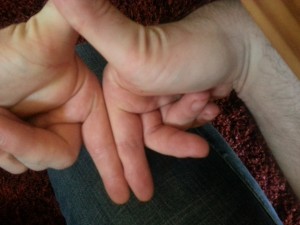 In this one it’s harder to prove that there’s no manipulation to alter finger length but it’s still another perspective. You can also see the osteophyte on my right finger. I studied a little bit about osteoarthritis and although osteophytes are a symptom of osteoarthritis they can be caused by other forms of mechanical stimuli too. So, just because I have osteophytes doesn’t mean I have osteoarthritis.
In this one it’s harder to prove that there’s no manipulation to alter finger length but it’s still another perspective. You can also see the osteophyte on my right finger. I studied a little bit about osteoarthritis and although osteophytes are a symptom of osteoarthritis they can be caused by other forms of mechanical stimuli too. So, just because I have osteophytes doesn’t mean I have osteoarthritis.
Now to prove that it’s not just enlarged joints and it’s actually the bone that’s longer.
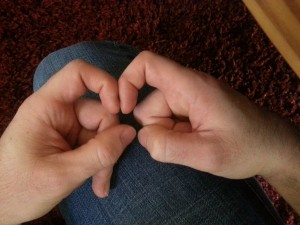 Comparison of two bones in the finger only and clearly the right finger bone is longer. So LSJL lengthens bones and does not just merely expand the synovial joint.
Comparison of two bones in the finger only and clearly the right finger bone is longer. So LSJL lengthens bones and does not just merely expand the synovial joint.
Now here’s a thumb comparison. I’ve only been doing LSJL on my left thumb and not my right. I figured it would be unlikely for someone to argue that my right hand has always had longer figures if my right index finger was longer then the left but my left thumb was longer than my right.
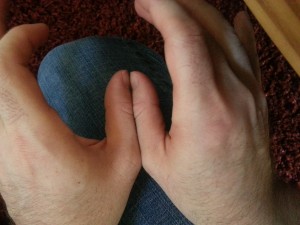 And it looks like the left thumb is longer but I can’t rule out measurement error since it’s hard to tell exactly when the thumb ends on the hand.
And it looks like the left thumb is longer but I can’t rule out measurement error since it’s hard to tell exactly when the thumb ends on the hand.
I have before pictures of each appendage but it’s much easier to compare side to side against the contralateral limb.
So here’s some more evidence of LSJL but hopefully also switching up the knee and ankle method will be able to prove LSJL there and that is the big ticket for proof. So look for Part II soon that explains the current LSJL technique I’m using(I have pretty much finalized the technique but need to take the pictures) and hopefully more LSJL proof.
Michael: I answered your later posts before this one, so I did not realize you accounted for synovial joint expansion. As for the one question you wanted answered, I will just go back to the fact that the fingers and the arms are not always being pushed upon. With the legs, since we are always walking, the effects of the clamping might be negated by the loading from just walking itself.
As for the osteophyte issue, it is a unique sign that something is not going correctly. Has osteophytes also developed in the finger bone segments which were not clamped?

